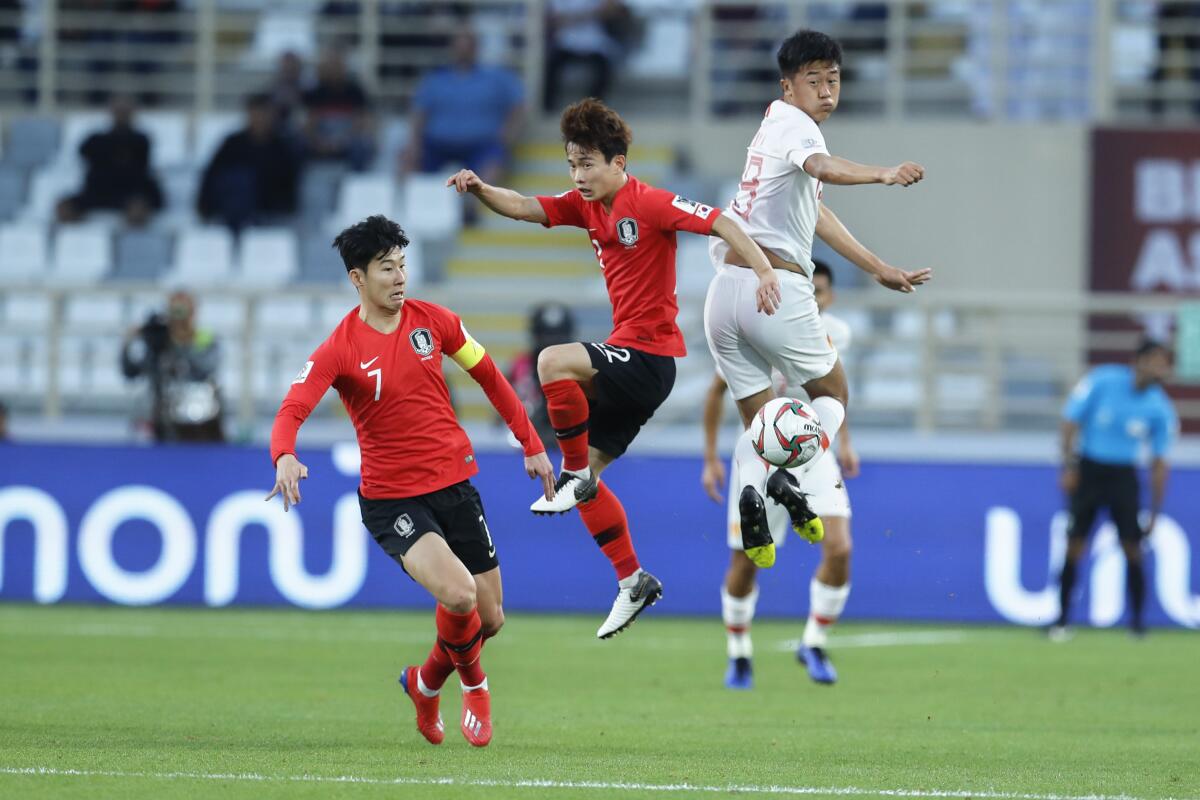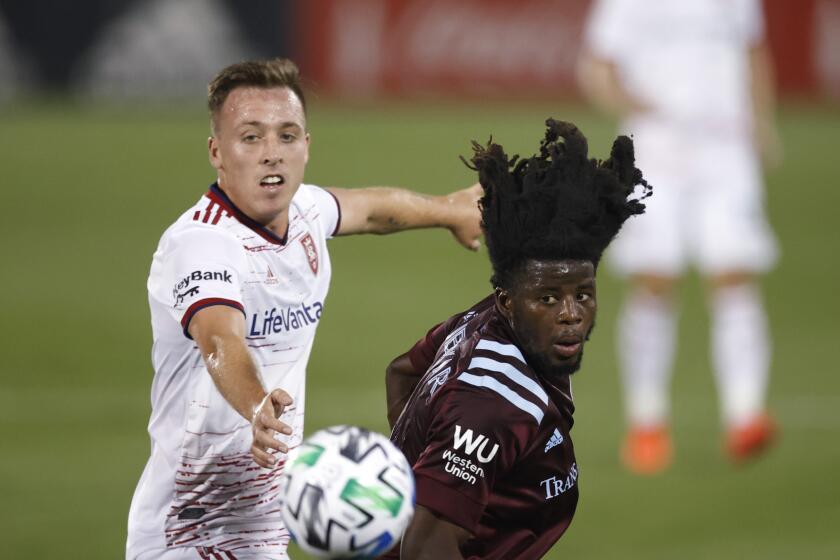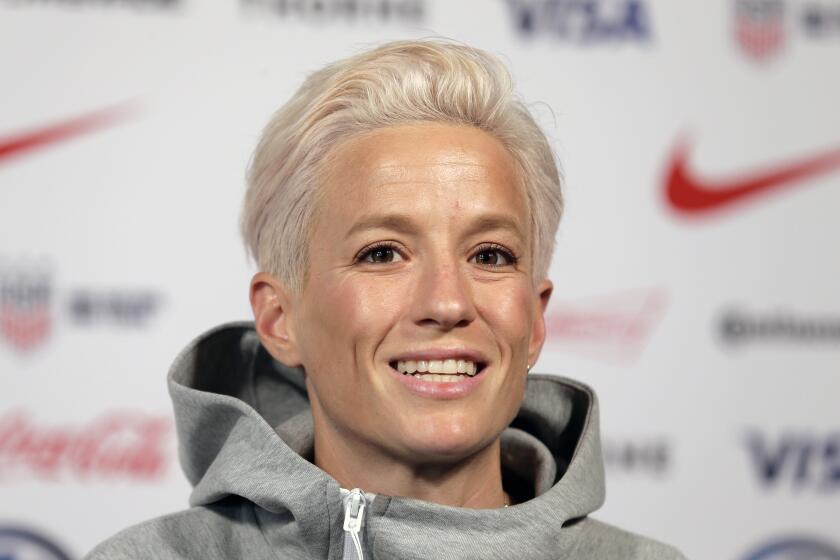Is LAFC trying to corner the Korean market in Los Angeles?

- Share via
As a boy growing up in the San Fernando Valley in the 1990s, Eric Choi remembers his parents trundling him off to soccer games at Cal State Northridge. But the attraction wasn’t so much the sport as it was one player, defender Ron Lou.
“I definitely didn’t have an Asian role model close by. And he was Asian, right?,” Choi said. “So my family, we claimed him.”
Choi not only claimed Lou, he followed him, first to Northridge, where he earned a degree in journalism, then into soccer, where he has coached the El Camino Real High girls’ team into a perennial powerhouse.
And he believes LAFC’s signing this week of Korean national team defender Kim Moon-hwan could have a similar impact in Southern California’s swelling Asian community, where children have grown accustomed to cheering Japanese and Korean baseball players but have rarely had a soccer star to call their own.
“It’s always nice to see people that are the same color represented or celebrated. Not just in sports but in all spectrums of life,” he said.
With MLS teams discovering an Asian market they have traditionally ignored, it’s a trend that could pay off both in the stands and on the field.
LAFC used an MLS-high 28 players in 2020, so general manager John Thorrington is placing a premium on versatility for 2021. These two moves reflect that.
Just one Korean – Galaxy defender Hong Myung-bo – played in MLS in the league’s first 16 seasons. But when Kim makes his LAFC debut this year, he’ll become the third in as many seasons and fifth overall.
MLS didn’t sign a Japanese player in its first decade; it has used 10 since 2012.
For LAFC, the addition of Kim isn’t so much the team following the league as it is adhering to the philosophy of general manager John Thorrington, who wants a roster that reflects Southern California’s ethnic diversity. That’s partly why he signed players from five continents and two dozen nationalities in the team’s first three seasons.
Kim, 25, a versatile outside back, is the team’s first Korean, something Yeol Jang, a journalist with Korea Daily, said “is great news” in the largest Korean community outside the peninsula.
“Sports have a lot of meaning to the Korean community. Because it is an immigrant community, Korean Americans have a longing for the motherland,” he said.
Garth Lagerwey, general manager of the Seattle Sounders, expects the influx of Koreans to MLS will continue. Not only does the country have a soccer culture, having qualified for nine consecutive World Cups — something the U.S., Italy, the Netherlands and France haven’t done — but its once-insular national team has begun exporting players to some of the biggest clubs in the world.
“Korean players are a good fit for MLS,” said Lagerwey, whose teams won the 2019 MLS Cup with a defense anchored by Korean center back Kim Kee-hee. “They are hard-working, industrious players who have good technical aptitude. It’s a good package for the type of league that MLS is.
“But the important thing is that the Korean players see MLS as a place where they can find success.”
So far they have, with the league serving as a springboard to other goals. Kim Kee-hee, for example, returned to Korea after two seasons in Seattle and won the Asian Champions League with Ulsan Hyundai last month, four months after midfielder Hwang In-beom jumped from the Vancouver Whitecaps to Rubin Kazan of the Russian Premier League.
Another reason MLS general managers have begun looking toward Asia is the fact South America, which sent 134 players to the league last season, has become so overheated many agents there now overvalue their clients.
“Being in a salary-cap system, you have to constantly find value,” Lagerwey said. “So you always have to be looking for the next thing. “I don’t know that there’s any specific fact pattern that say Korea is that thing. [But] I do think highly of the Korean market.”
Megan Rapinoe, the 2019 FIFA player of the year, didn’t hold back when asked about the rioting. ‘This was about holding up white supremacy,’ she said.
Language, Lagerwey said, can be a problem with Asian players but it’s one the Sounders solved with a translator and a mobile-phone app.
“One of our translators would have Google translate open,” he said. “If we had to convey something in training, we could say it in the program and it could spit out enough Korean to help him understand.”
But for Jerry Kang, a professor of law and Asian-American Studies at UCLA, MLS’ interest in Korea is furthering another more important understanding. By providing the kind of role models Eric Choi had to search for as a boy, Kang said the league is opening up opportunities for another generation.
“What we can imagine is often constrained by what we can see,” he said. “So for Korean American or Asian American kids growing up in Los Angeles, seeing a professional athlete who looks like them helps change what’s possible.”









